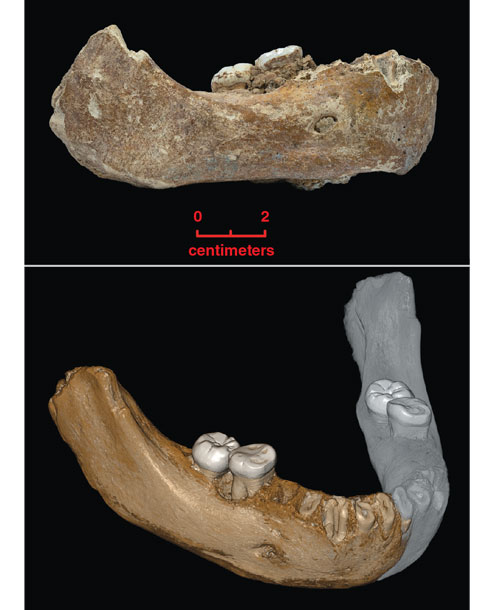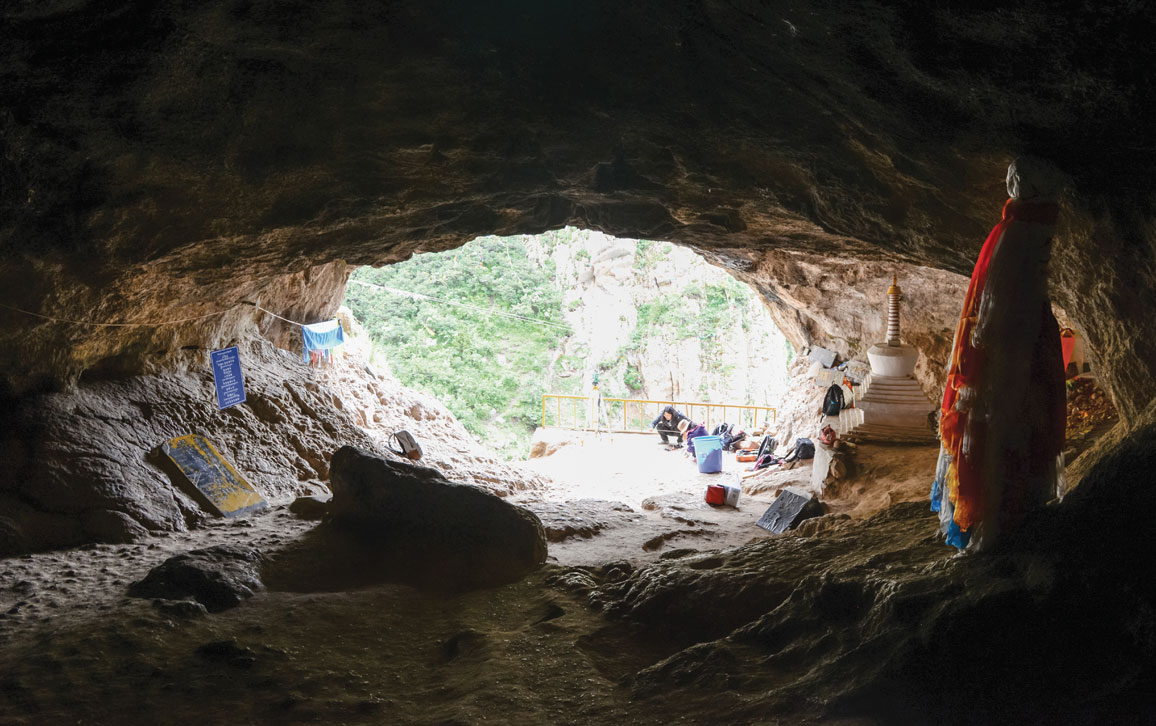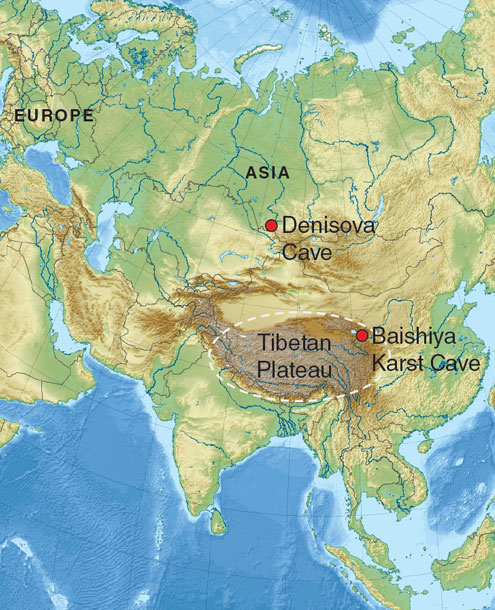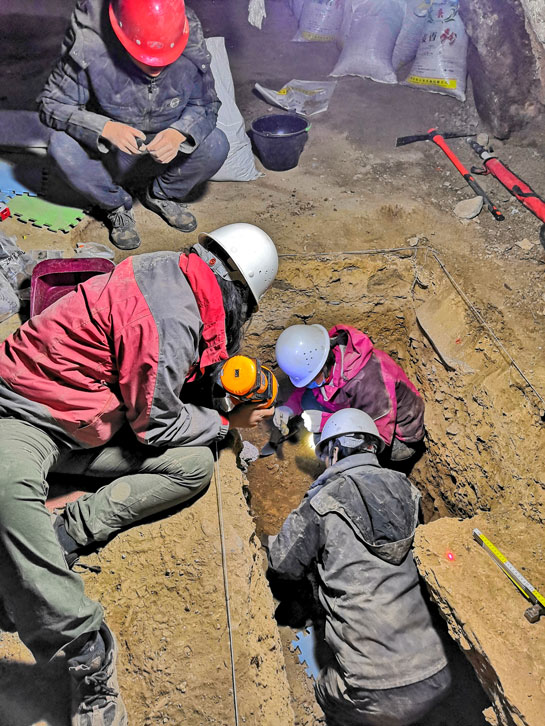What This Half-Jaw Could Tell Us
By Sandra J. Ackerman
Fossils of human ancestors are rare and priceless, but the geological context in which they are found can offer equally valuable information.
Fossils of human ancestors are rare and priceless, but the geological context in which they are found can offer equally valuable information.

A fossilized fragment of a hominin jawbone has made a powerful impression in paleoanthropological circles recently—and not just because of the bonus inclusion of two intact molars. Found in a cave in Xiahe, Gansu, China, the fossil is remarkable for its age: about 160,000 years old, according to uranium-thorium dating of the carbonate crust adhering to its surface.
The Xiahe fossil provides “the earliest traces, by far,” of a human presence on the Tibetan Plateau, says Frido Welker, a postdoctoral researcher at the University of Copenhagen and an author of a May 16 letter in Nature describing the new find. Before that publication, scholarly consensus had estimated human habitation of this inhospitable region at no more than 30,000 to 40,000 years ago.

© Dongju Zhang, Lanzhou University; Jean-Jacques Hublin, MPI-EVA, Leipzig
In addition to its age, the specific identity of the fossil makes it newsworthy: Mass-spectrometry analysis of ancient proteins from the dentine in a tooth has allowed researchers to classify this individual as Denisovan, a taxon often described as a sister-group to Neanderthals. The Denisovans are named for Denisova Cave in southern Siberia, where the first evidence of this group was discovered in 2010. As the only Denisovan specimen that has been found outside the original site, the Xiahe mandible adds a great deal of morphological information to an emerging picture. It’s a picture that originally was a blank slate, because the first reports of Denisovans were based only on the analysis of mitochondrial DNA from a single bone in the pinky finger of a hominin who had lived in the cave more than 30,000 years ago. (Since that time, the whole nuclear genome has been sequenced.)
To Jean-Jacques Hublin, a lead author of the Nature letter, the initial lack of a tangible specimen is part of what makes Denisovans “one of the most mysterious groups of hominins,” because they were introduced into the scientific literature as a conceptual species, so to speak, rather than a physical one. “Such a claim was completely new at the time, and it struck the public imagination,” says Hublin. The publication soon afterward of information about an isolated molar whose DNA showed it to be Denisovan was not enough to dispel the mystery.
With the publication of the Xiahe fossil—a solid half-jawbone (plus two teeth)—the idea of Denisovans finally gains some heft. At the same time, though, the location of this find offers fresh evidence that the Denisovans were a remarkable people. Both the Baishiya and the Denisova caves are located in mountainous areas that are difficult to navigate, and the two are separated by at least 2,200 kilometers of challenging terrain. Even more striking is the difference in altitude between the two caves: Whereas Denisova lies just 700 meters above sea level, Baishiya is at least 2,500 meters higher. “This, to me, is the most surprising aspect of the Xiahe site,” says Hublin, because living at the extremely high altitude of Baishiya Karst Cave requires a special adaptation that prevents the overproduction of red blood cells, as would normally occur in the average person who is suddenly exposed to a low-oxygen environment. The adaptation is controlled by a particular allele of the EPAS1 gene, prevalent to this day in the inhabitants of the Tibetan high plateau.
Baishiya Karst Cave, named as the original location of the fossil, is a sacred site reserved for prayer and meditation by the Buddhist monks of the area. One of numerous caverns hollowed out from the steep crags of the Himalayas, Baishiya has been known locally for some time as a source of holy bones that could be ground up to make various medicines. It was fortuitous, therefore, that the monk who discovered the mandible in the cave in 1980 decided instead to hand it over to the Sixth Gung-Thang Living Buddha, who in turn gave it to scientists at nearby Lanzhou University for safekeeping.

© Dongju Zhang, Lanzhou University
In another fortunate turn of events, no one in this chain of custody attempted to “clean” the fossil by removing the carbonate crust on its surface. By the time the specimen came under scientific examination, imaging technology was available that allowed researchers to remove the crust virtually—that is, by CT scanning and computer manipulation of the images—while leaving the physical object intact. Researchers thus were able to study the entire surface of the fossil without undertaking the risky process of removing the precious sediment on it.

Barbara Aulicino/Wikimedia Commons
Steven Goldstein, of the Max Planck Institute for the Science of Human History, in Jena, Germany, hails the introduction of the Xiahe mandible along with many other scientists. “The actual science and the analyses in the report are absolutely excellent, and it’s amazing that we’re now able to do these kinds of studies,” he says. However, as an archaeologist, Goldstein is troubled by the lack of information about the geological context of the find. “I’ve never seen a new fossil described with so little documentation on the geological sequence of the supposed deposits when there have been excavations of the site to draw on,” he says. “Ideally, we want to see the site strata, or fossils and artifacts that may be associated with the site.”
Such documentation would add greatly to the value of a report, allowing researchers in related fields to weigh alternative interpretations of the data or to follow their own lines of investigation. Moreover, beyond its potential to be useful, the inclusion of such data in a standard way helps to keep archaeology grounded as a scientific field, Goldstein explains: “Part of what separates archaeologists from antiquarians or souvenir hunters or just plain looters is that we put the facts out there and let them speak for themselves. In the same way that we’re concerned about keeping a record of lab protocols and procedures to make sure an experiment is reproducible, we have to lay out all the specific information we can possibly gather about the sites we study.”
The report on the Xiahe fossil does in fact include a considerable amount of supplementary information on methods of dating, on protein analysis and phylogenetic analysis, and on the site of Baishiya Karst Cave itself, but without specifics of the stratigraphy. “Our Chinese colleagues at Langzhou University seem to have a well-kept history of the conditions in which the mandible was found,” says Welker, adding that because the cave is a sacred site, access to it has always been kept under strict limits.
The find from Baishiya Karst Cave has opened an entirely new chapter in Himalayan archaeology.
For Hublin, who hypothesized in 2013 that Denisovans were represented in the Chinese fossil record although still undetected, the Xiahe find is highly gratifying—all the more so because it dates from a time in evolutionary history when hominins were undergoing tremendous diversification. Neanderthals, Denisovans, Homo naledi, Homo floresiensis (the so-called hobbit people of Flores, Indonesia), and the very recently discovered Homo luzonensis of the Philippine Islands all flourished during this period. Every new puzzle piece that turns up enriches the whole picture. As for the undocumented geological context of the fossil, Hublin is undeterred. “The fact is that sediment from the surroundings remains on the mandible,” he says, and this material has provided at least a minimum age.
Besides, there is still plenty of work to do. Says Hublin, “What’s ahead of us is to excavate a stratigraphic series in the cave where the mandible was found, to relate the fossil to a stratum, and we will need to carry out paleoprotein analysis on other Chinese specimens that do not preserve ancient DNA.”

© Dongju Zhang, Lanzhou University
Goldstein, for his part, would be happy to see more data from Baishiya Karst Cave. “Of course the archaeological and paleontological record is very messy, and we almost never get all the information we want,” he says, “but it troubles me when a report that omits significant details is presented as if it were complete. There’s a big difference between flatly stating, ‘This was found here,’ and saying, ‘We think, or as best we know, this was found here,’ which is really closer to the case.”
At the very least there is general agreement on the hope that the Xiahe mandible will be the first of many exciting discoveries in this region. “The find from Baishiya Karst Cave has opened up an entirely new chapter in Himalayan archaeology,” says Welker. To this, Hublin adds another bookish figure analogy: Up to now, he says, “Asia has been a little bit like the Sleeping Beauty of paleoanthropology.”
Click "American Scientist" to access home page
American Scientist Comments and Discussion
To discuss our articles or comment on them, please share them and tag American Scientist on social media platforms. Here are links to our profiles on Twitter, Facebook, and LinkedIn.
If we re-share your post, we will moderate comments/discussion following our comments policy.